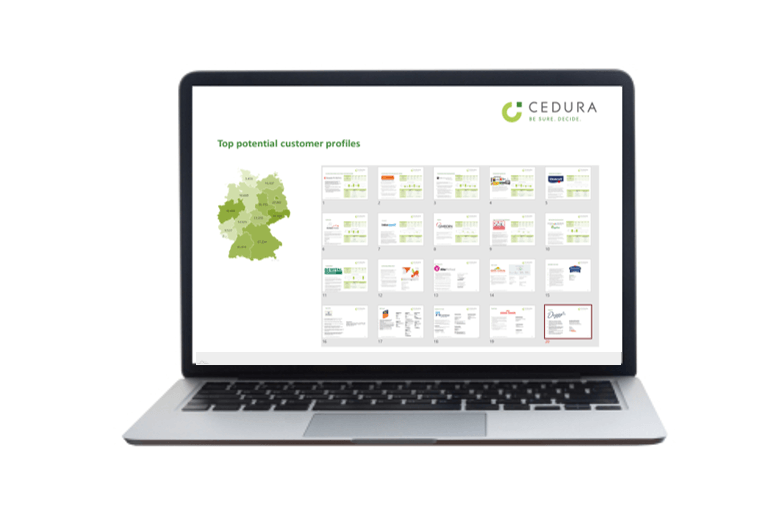Find potential customers – Blog Post by CEDURA
In recent months, especially in the B2B sector, we’ve noticed an increased demand for qualified and specific information about potential customers. Due to ever faster innovation cycles and geopolitical conditions, our markets are changing much more rapidly than we’re accustomed to.
In my opinion, the identification of potential customers must take these constant developments into account, and this can only be achieved through the continuous collection, linkage, and analysis of all information within your relevant market = market intelligence. This includes:
- Competitors
- Customer industries
- Product innovations
- Trends in emerging markets
- Regional shifts in demand
To systematically find (new) potential customers who need your current or future offerings, you can, for example, ask yourself the following questions and start from the second point, letting market intelligence answer them.
1. Defining the boundaries of our relevant market based on our own capabilities
Refers to how companies define their range of services and differentiate themselves from competitors. It involves clearly determining the products or services offered, the target demographics served, and the values provided to customers. This approach enables companies to utilize resources efficiently and tailor their communication to various target audiences.
This includes questions such as:
- What products or services do you currently offer?
- What specific skills or competencies do you possess that differentiate you from competitors?
- What new products or services do you plan to offer in the future?
- How can you improve your existing products or services to better meet the needs of your customers?
- How do you position yourself compared to your competitors and how do you differentiate yourself from them?
- What additional value do you offer your customers with your current offerings?
- Which customer needs are you already successfully addressing and how can you further expand on them?
- Which market segments or target groups do you want to address and why?
- What resources, technologies, or partnerships can you leverage to improve your capabilities and expand your market?
- How can you react to changes in the market environment and adjust your positioning accordingly to remain competitive?
2. Defining the boundaries of the relevant customer groups
This includes how companies identify and segment their target audiences. Thanks to market intelligence, you can precisely determine which potential customers demand the company’s products or services and what characteristics these customers have in common. This enables companies to use their resources efficiently and develop tailored approaches for various potential customer groups.
Among these are questions like:
- Which customer groups are you currently targeting?
- What specific needs or requirements do these customer groups have?
- Which potential customer groups would you like to target in the future?
- How can you tailor your range of products or services to meet the needs of your customer groups?
- How do your customer groups differ from each other, and how can you account for these differences?
- What benefits do you offer to the various customer groups with your current offerings?
- Which customer groups are particularly important for your company and why?
- How can you adapt your marketing and sales strategies to the different customer groups?
- Which communication channels and messages are most effective for the various customer groups?
- How can you continuously improve your understanding of the needs and behaviors of your customer groups to strengthen your market position?
3. Know the market potential and competitors
It refers to the fact that companies consciously engage with the overall market and its opportunities as well as with existing competitors. Market intelligence helps understand the market potential for one’s own products or services by analyzing the market size, growth potential, trends, and other relevant factors. At the same time, it is important to know the competitors, identify their strengths and weaknesses, and understand their strategies. This enables companies to make informed decisions, strengthen their position in the market and gain competitive advantages.
This encompasses questions like:
- How successful are your competitors in the market?
- What market shares do your competitors have, and how did they achieve them?
- What products or services do your competitors offer, and how do they differ from your own?
- What are the strengths of your competitors that make them successful?
- What weaknesses do your competitors have that you could exploit?
- How do your competitors position themselves in terms of price, quality, and service?
- What marketing and sales strategies do your competitors employ?
- How do your competitors respond to market developments and trends?
- Which customer needs do your competitors address particularly successfully?
- In what ways can you learn from the strategies and experiences of your competitors to better position and improve your own company?
After answering the questions, the result may be ‘just’ a list of potential customers. However, the path to get there is crucial for the quality of these potential customers, as thorough market research ensures that companies can target the right customers and build long-term, profitable relationships.
And if you want to address new customers specifically, cleverly executed market intelligence can even provide the corresponding arguments in the form of sales argumentation cards.
Interested in a personal exchange on the topic of market intelligence? Feel free to contact us.
Find more helpful tips and information in english on our Vimeo channel.






0 Comments